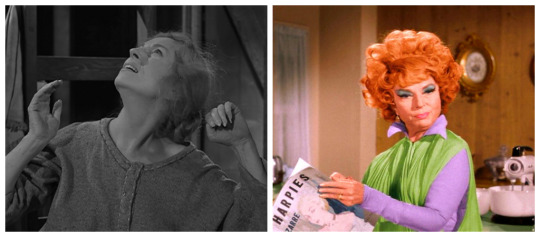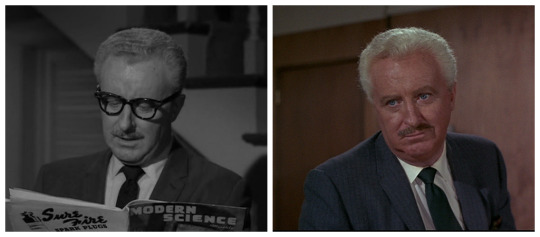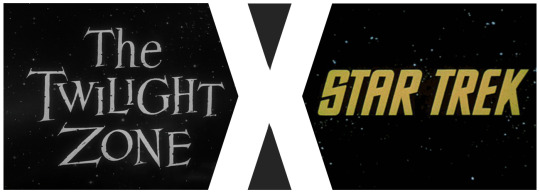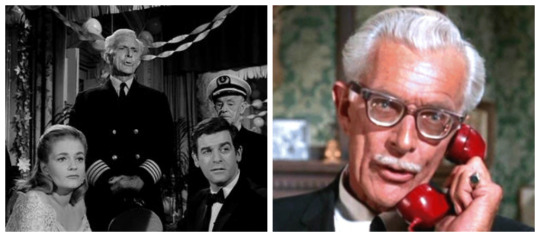#WHAT KIND OF TWILIGHT ZONE MONTGOMERY IS THIS
Text
Me: *casually completes an artwork*
The News: “So yeah uhhhh hhhhh hrmmmnnnghh erummmmmm <Famous Person> has met their demise today.”
Me:

#recently an indian comedian known as Vivek met his sudden fate as soon as i finally made the touches to my hand-made backpack today#this comes days after i completed a laurel crown on the day prince philip passed away last week#WHAT KIND OF TWILIGHT ZONE MONTGOMERY IS THIS#WHAT IS GOING ON#what#oh no
1 note
·
View note
Text
Familiar Faces from the 5th Dimension

Getting a role on The Twilight Zone was a hot ticket, particularly in its first few years. Rod Serling had built up considerable cache with his well-received teleplays for drama anthology shows like Playhouse 90 and The Desilu Playhouse (where The Time Element originally appeared) and the Peabody-winning Requiem for a Heavyweight. Twilight Zone features appearances from lots of big-name actors from film, television, and radio as well as actors that would go on to become household names.

Often when this sort of topic is covered, the discussion centers on future award-winning film actors like the Roberts Redford and Duvall so I thought I’d take a moment to celebrate the small screen. Below is a sampling of familiar faces between The Twilight Zone and some other hugely popular mid-century television shows: Bewitched, Star Trek, and Batman.
BELOW THE JUMP
Bewitched (1964-1972)

In addition to some shared directors, most of the major stars of Bewitched appeared on The Twilight Zone. The Bewitched cast made out very well for themselves in the 5th dimension: their episodes are all good to great!
Dick York (Darrin Stephens)
in A Penny for your Thoughts 2.16 as Hector B. Poole and in The Purple Testament 1.19 as Capt. Phil Riker

Two very different stories here, both about psychic powers. Penny is a funny, screwball sort of episode about a hapless bank employee unexpectedly gifted with telepathy and Testament follows a soldier who starts getting premonitions of who’ll die next. If you like York’s Derwood mugging, you’ll love Penny.
Agnes Moorehead (Endora)
in The Invaders 2.15 as the Woman

If you read my Twilight Zone post from yesterday, you know this one is an all-time fave of mine. Moorehead still has loads of witchy energy in this episode, albeit a very different, unglamorous kind of witchy.
Elizabeth Montgomery (Samantha Stephens)
in Two 3.01 as the Woman (but y’know a different one from Agnes…)

Montgomery and Charles Bronson play two lone soldiers on opposite sides of a war that has ended in apocalypse. The story works through what happens to those soldiers when there’s little more to fight over. It’s a very Rod Serling concept though I’m lukewarm on the resolution. Now, Inger Stevens is great in The Lateness of the Hour, but I always wonder about how great Montgomery would have been in the role.
David White (Larry Tate)
in I Sing the Body Electric 3.35 as George Rogers

I also covered this episode in yesterday’s post. White’s character in I Sing couldn’t be further from the selfish and obtrusive Larry Tate and it’s fun to see him as a sympathetic single dad trying to do what’s best for his kids.
Small Roles: Sandra Gould (Gladys Kravitz #2) in Cavender is Coming 3.36 & What’s in the Box 5.24, Alice Pearce (Gladys Kravitz #1) in Static 2.20.
Honorable Mention goes to Maurice Evans (Maurice) in Planet of the Apes (1968) as Dr. Zaius because Rod Serling wrote the screenplay.
Star Trek (1966-1969)

Star Trek and The Twilight Zone have a ton of cast in common, especially when you include guest spots. Half of the Enterprise’s bridge crew appeared on The Twilight Zone and even their engineer. Unlike with the Bewitched stars, the Star Trek actors have a spotty record on Twilight Zone. Both of Shatner’s episodes are true classics, but Nimoy and Takei are in some troubling territory.
Twilight Zone writers George Clayton Johnson and Richard Matheson also wrote episodes of Star Trek, respectively The Man Trap and The Enemy Within.
William Shatner (James T. Kirk)
In Nick of Time 2.07 as Don Carter and Nightmare at 20,000 Feet 5.03 as Bob Wilson

Bit of Trivia: When Richard Matheson wrote Nightmare, knowing Shatner would likely star, he wanted to make Bob Wilson Don Carter following his inevitable nervous breakdown after Nick of Time. When Patty Breslin was unavailable for Nightmare, the plan was scrapped.
Leonard Nimoy (Spock)
in A Quality of Mercy 3.15 as Hansen

A jingoistic WWII soldier (Dean Stockwell) is all-too eager to kill and it takes a Freaky Friday situation for him to learn a lesson about mercy. Nimoy’s role is a small one here, but maybe that’s a good thing.
James Doohan (Scotty)
in Valley of the Shadow 4.03 as a Father

A reporter takes a wrong turn roundabout Albuquerque and finds himself in a town with a secret. He makes the mistake of asking questions after Doohan’s daughter disappears his dog and things get messy from there. Valley of the Shadow is one of the best episodes from this season of drawn-out stories and it often feels like a Star Trek plot.
George Takei (Sulu)
in The Encounter 5.31 as Arthur Takamori

Just don’t.
Small Roles (too many to mention): Susan Oliver (Vina from Star Trek’s pilot) in People Are Alike All Over 1.25, Arlene Martel (T’Pring) in Twenty-Two 2.17 and What You Need 1.12.
Batman (1966-1968)

We never had the pleasure of the caped crusader himself on The Twilight Zone, but we do have two of his greatest nemeses and his butler.
Burgess Meredith (The Penguin)
in Time Enough at Last 1.08 as Henry Bemis and in Mr. Dingle, the Strong 2.19 as Mr. Dingle and in The Obsolete Man 2.29 as Romney Wordsworth and in Printer’s Devil 4.09 as Mr. Smith

Burgess Meredith is tied with Jack Klugman for most starring spots on The Twilight Zone; Meredith’s episodes hew more toward the humorous though. Printer’s Devil is probably the least seen of Meredith’s appearances and that’s a shame. He’s got a cigarillo-chomping menace that builds steadily throughout the story.
Julie Newmar (Catwoman)
in Of Late I Think of Cliffordville 4.14 as Miss Devlin

A bored robber baron cuts a deal with the devil (Newmar) to go back in time to his hometown so he can change a thing or two about his past. Unfortunately for him, even non-traditional Faustian bargains have their pitfalls. Newmar is spectacular as the sly and charming “travel agent.” You can definitely see some roots of what Newmar would later put into her portrayal of Catwoman.
Alan Napier (Alfred)
in Passage on the Lady Anne 4.17 as Capt. Protheroe

A young couple books passage on the wrong ship according to all the strange elderly people on the ship. Passage is a spooky concept that’s just too drawn out. This would have made a very memorable 30-minute episode though.
Small Roles: Stafford Repp (Chief O’Hara) in Nick of Time 2.07 and in The Grave 3.07 and in Caesar and Me 5.28.
Many many one-time special guest villains also appeared!
These are just a few fun shows that followed The Twilight Zone and have more than a smattering of cast and crew in common. It’s the tip of the iceberg, really. The Beverly Hillbillies also had a ton of crossover performers, but since the Clampetts aren’t psychics or villains, the connections aren’t quite as fun to make!

I don’t think so anyway...
#The Twilight Zone#Twilight Zone#Twilight Zone Marathon#syfy#playhouse 90#television#tv#1960s#sitcoms#scifi#sci-fi#science fiction#bewitched#batman#star trek#tos#star trek tos#william shatner#leonard nimoy#george takei#james doohan#agnes moorehead#elizabeth montgomery#dick york#david white#julie newmar#burgess meredith#alan napier#batman 66#list
95 notes
·
View notes
Text
WandaVision: The Sitcom Influences of Episodes 1 and 2
https://ift.tt/eA8V8J
Marvel was never shy about promoting that its first Disney+ series, WandaVision, was inspired by classic TV sitcoms. The show’s trailers revealed its concept of Wanda Maximoff (Elizabeth Olsen) and The Vision (Paul Bettany) living a classic sitcom lifestyle, laughtrack and all. In the show’s posters, Wanda, Vision, and other characters like Agnes (Kathryn Hahn) are made up of literal TV sets. Producer/Marvel head Kevin Feige, head writer Jac Schaeffer, and director Matt Shakman all went through what they describe as a “sitcom school.”
Still, even with all that forewarning, it’s hard to contain one’s surprise at just how seriously and literal WandaVision takes its sitcom mission. Save for a handful of moments that suggest all is not what it seems, WandaVision’s first two episodes are made up entirely of classic sitcom plots. In one, Wanda and Vis endure many classic sitcom misunderstandings as the latter’s boss makes an unexpected appearance at dinner. In the second, the pair must concoct a magic show for Westview’s kids…all while Vision is basically drunk on chewing gum.
This is a bold new direction for Marvel’s storytelling. The franchise is beginning its future on television by looking to the medium’s past. Given that Feige, Schaeffer, Shakman, and company went to such efforts to create as “sitcom-y” experience as possible, it’s only fair that we delve into the episodes and identify all the sitcoms it’s paying homage to. What follows are our findings.
The Dick Van Dyke Show
The Dick Van Dyke Show is the clearest influence on WandaVision’s first two episodes. The first episode in particular closely resembles the aesthetic of the classic Van Dyke and Mary Tyler Moore-starring show. Wanda and Vision’s home appears to be at least partially modeled off of the Petrie’s abode. Right inside the entrance of the front door is a small landing leading to a lowered living room floor. Van Dyke would step off that landing and theatrically pratfall over an Ottoman in the show’s opener.
Even Wanda and Vision’s kitchen appears to be modeled after the Petrie’s, with ample counter space and shuttered windows leading out into the living room. This modeling of the Van Dyke Show home for WandaVision’s main dwelling was clearly no accident. In fact, as part of their aforementioned “sitcom school” the producers had lunch with the still sprightly and energetic 95-year-old Van Dyke to discuss the finer points of sitcoms.
“That remains one of the great afternoons of my life,” Shakman told reporters about meeting the comedy legend. “We asked him, ‘What was the sort of governing principle behind the Dick Van Dyke Show? Why did it work so well?’ And he said if it couldn’t happen in real life, it can’t happen on the show. If you’re drawing something that’s grounded and it’s real and it’s resonating with everyone’s experience at home, you can do crazy things.”
Imagine Shakman’s heart dropping during the first part of Van Dyke’s quote, realizing that he was about to make a sitcom about a magic-user and her android boyfriend. But it’s the second part of Van Dyke’s message that matters. Viewers can accept pratfalls over Ottomans or even tea saucers flying via ESP as long as the characters feel grounded.
Watch everything Marvel and more on Disney+, right here!
WandaVision is dealing with fantastical circumstances to begin with…and that’s before little “glitches” in its characters’ reality suggest that none of this is real. The importance of opening with a setting as grounded and recognizable as The Dick Van Dyke Show therefore cannot be overstated.
I Love Lucy
While The Dick Van Dyke Show makes up most of episode 1 and 2’s settings and vibes, there is also a little bit of I Love Lucy sprinkled in there. And that’s partially because there’s almost always a little bit of I Love Lucy sprinkled into every sitcom.
I Love Lucy is one of the most influential shows of all time. Lucille Ball starred as a fictionalized version of herself, Lucy Ricardo, a young middle-class housewife living in New York City with her husband Ricky Ricardo (Desi Arnaz). Episode 1’s opening theme song (written by EGOT winners Kristen Anderson-Lopez and Robert Lopez) mentions that Wanda and Vision are relocating from the city to a smaller town, so the setting is not similar, but it’s still hard for the show to avoid Lucy comparisons all the same.
In speaking to reporters Olsen mentioned Lucy as an “accidental” inspiration for her performance, saying: “It was like an amalgamation of Mary Tyler Moore and Elizabeth Montgomery (of Bewitched). I think I accidentally threw in some Lucy in the ‘70s just because there was so much physical comedy.”
Feige also invoked I Love Lucy when talking about styling the black and white episodes.
“We often talked about that when something shifted from a Dick Van Dyke or an I Love Lucy style into something that was outside of that, that it was going into kind of a Twilight Zone,” Feige said. “You know, we were thinking about what were the period shows that addressed, you know, the odd and the strange, and how could we embrace that?”
One tangible aspect in which WandaVision pays homage to I Love Lucy is in Wanda and Vision’s separate twin beds at the beginning of the second episode. In the 1930s through the 1950s, TV characters, married or otherwise, almost never shared the same marital bed. The Hays Code explicitly mentioned “Man and woman in bed together” as an image to avoid. As the most popular sitcom of the time, I Love Lucy became something of a hallmark of this strange rule. It was downright jarring to see a couple so clearly close as Lucy and Ricky spending their nights in separate twin beds.
Thankfully, shortly into the episode Wanda uses her magic to conjoin her and Vision’s beds. And that gives her something in common with another TV witch…
Bewitched
Funnily enough, the first live-action TV couple (who weren’t already married in real life) to share a bed were Darrin and Samantha Stephens on Bewitched. And it’s from that show that WandaVision episode 2 borrows much of its format.
The opening credits for WandaVision episode two are highly, highly similar to Bewitched’s animated opener. (There’s also some I Dream of Jeannie influence, which makes sense as that show basically copied Bewitched.)
The general conceit of the episode is right out of a Bewitched episode as well. When her husband (Vision in WandaVision and Darrin Stephens on Bewitched) encounters some trouble, our witch protagonist (Wanda and Samantha Stephens) uses her magic to help him out. It’s a bit of an ironic twist, however, that Wanda uses her magic to make Vision’s own “magic” seem like simple sleight of hand trickery.
Though Bewitched makes up most of the inspiration of WandaVision’s second episode, its influence can also be felt in episode 1. When Wanda uses her powers to make recipe cards float all around her, the show borrows a simple string special effect from Bewitched.
“Our special effects team usually blows things up, sets things on fire, creates wind, creates smoke – (now) these guys became like puppeteers of things floating in the sky and dealing with magnets,” Olsen told reporters. “It was just so incredible to watch them adapt to the specific ways of creating these practical effects by doing the research of what they did on Bewitched.”
Bewitched also aired its first 74 episodes in black and white before switching to color for its next 180. WandaVision’s transition to color at episode’s end could be an homage to that…or it could just be setting up all the other exciting sitcom references to come.
cnx.cmd.push(function() { cnx({ playerId: "106e33c0-3911-473c-b599-b1426db57530", }).render("0270c398a82f44f49c23c16122516796"); });
The post WandaVision: The Sitcom Influences of Episodes 1 and 2 appeared first on Den of Geek.
from Den of Geek https://ift.tt/3bPKAet
0 notes
Text
We people of Earth are experiencing a renaissance in horror on TV like we’ve never enjoyed before, as traditional gatekeepers are dispersed in the wild hunt for content, any content that is compelling or innovative or just plain outré enough to collect people at watercoolers, where presumably advertisers can drop a net on the whole pack and harvest their disposable incomes and/or pineal juices. There’s Scream Queens, Scream, American Horror Story, Ash Vs. Evil Dead, Stranger Things, Bates Motel, and so many more jostling for your eyeballs, and they are all worthy of your eyeballs. The surprisingly gory Supernatural is in its 80th season, I think, and The Walking Dead has proven itself stronger than even zombie fatigue. And for every Penny Dreadful or Hannibal that is cut down, a Twin Peaks or X-Files will rise. But everyone in my house is sick, and have been in various configurations for the last month and a half, so I can’t tell you about any of those new shiny things at the moment. Sick babies are hell on your Netflix queue. And while David Cronenberg and Anthony Burgess’ epidemiologic horror is also top of mind these days, I find myself ultimately retreating to the comfort food of old favorites. In this case, the genteel rictus smile of Boris Karloff’s Thriller.
Stephen King had high praise for Thriller in 1981’s Danse Macabre*, and you’ve got to respect Stephen King’s opinion in these matters. Deference to King aside, since it wasn’t widely syndicated like The Twilight Zone, The Outer Limits, Alfred Hitchcock’s anthology shows, and a slew of others, and I fall in the Gen X cohort that missed the first go-around, I never actually clapped eyes on the show until Netflix picked it up a few years ago. There’s only two seasons, but these are 1960s seasons, so the hour-long format delivers a full 50 minutes of content, not the 37-42 minutes we get today, with a total of 67 episodes, so it certainly doesn’t feel like a short-lived series. I think a show would have to be on for almost a decade in Britain to ding 67 eps.
In a lot of ways, Thriller is just like its horror anthology contemporaries and successors: weird standalone teleplays – usually horror, but sometimes a crime or mystery story — starring many faces who, if not already famous and beloved, would certainly become so later on: Ida Lupino (who also directed a boatload of these and scripted one), John Carradine, Leslie Neilsen, Ursula Andress, William Shatner, Harry Townes, Elizabeth Montgomery, Rip Torn, Mary Tyler Moore, and on and on and on. The stories tended to be horror siphoned from a very EC Comics vein, where bad people succeeded in bad things, only to be visited with hells of their own making. The most upfront difference was its host, a man once simply billed by his forbidding last name in Universal’s horror heyday, Boris Karloff, who also starred in a handful of the stories as a glorious bonus.
Boris was a big value add, no question, not only bringing the heft of his horror credentials, but investing every host segment with superbly ghoulish glee. Each episode, after an appropriately shocking cold open, Boris would step into the scene or the camera would pan to reveal him, much in the manner of Rod Serling’s introductions in The Twilight Zone, but instead of Serling’s moralistic omniscience, Boris was conversational and warm, and the bloodier the subject matter, the more delighted he seemed. It’s a neat trick, possibly unparalleled, to be at once so kindly and so sinister. I could watch nothing but a loop of his host sequences for hours. And Boris really worked for it. When he warned, “And those were no ordinary pigeons. They were pigeons from hell!” you knew he meant it. Before the lights went down for the story proper to begin, he would also introduce the cast, reminding you of the unreality of it all briefly before returning to his convivial threats. I love these sequences, especially when the cast physically walks into the picture with Boris, looking haunted or malign, and I love that, at least initially, Boris referred to them as “Mr. Rip Torn. Miss Patricia Barry,” etc. It’s exquisitely mannered. The tagline was, “As sure as my name is Boris Karloff, this one is a Thriller!” And he was pretty true to his word.**
There were a few clunkers, though there always are, and even the success of the better episodes may be a matter of taste, particularly several decades after some of the punchlines and the story outlines have been retold so often they’re blunted with quaintess. But the source material was as top notch as The Twilight Zone at its height, harvesting work from August Derleth, Robert E. Howard, Richard Matheson, and particularly Robert Bloch, who wrote seven episodes. And hell, Ray Milland directed an episode about Jack the Ripper. There was a ton of talent going into these shows, and if it had had a better timeslot, maybe it would have survived to become the institution The Twilight Zone (deservedly) is. Thriller did at least spawn a comic series, Boris Karloff Tales of Mystery, which survived the show and Karloff both into the 1980s.
My favorite Thriller episodes all turn on that EC Comics flavor horror. You could easily swap out Boris for the Crypt Keeper as far as that goes, but I do prefer Karloff’s puns. Here, in no particular order, are my five top Thriller episodes for the adventurous viewer. There’s a DVD collection, plus it’s currently showing on the Decades cable channel. You may find many episodes on YouTube.
William Shatner did two Thriller episodes, and I have a hard time picking a favorite. Part of this is simply because Shatner’s really good in both. People make fun, but he’s a damn fine actor, and his black-and-white work could be a lot more restrained than we expect from Captain Kirk or Denny Crane. In “The Hungry Glass,” based on a Robert Bloch story, Shatner is one half of a young married couple who have just bought a house . They were sold the house by a realtor friend, who you may also recognize as Russell “The Professor” Johnson, and it has a spooky reputation that has kept the Century 21 sign out front for a generation. When the Shatners take possession of the house, they’re there for approximately a minute before the realtor’s wife screams that she saw a figure outside the window, and it’s not Torgo because the window overlooks a scenic sheer drop. There are nervous chuckles and rationalizations, but it doesn’t take very long at all for Shatner and his wife to start seeing fleeting figures in reflective surfaces. And then the wife finds an attic full of mirrors.
The second Shatner episode is called “The Grim Reaper,” another Bloch adaptation, and it stars a cursed painting that really looks like sweet heavy metal van art. Here, Shatner is the nephew of a different castaway, Natalie Schafer, who plays an eccentric, exuberant, and very alcoholic mystery writer. She recently acquired the cursed painting because she’s the kind of person who would, and her caring nephew has come to warn her off of it. As he explains, when the scythe of the depicted grim reaper drips blood, someone will soon die. And wouldn’t you know it? He touches the painting to demonstrate and comes away with bloody fingertips. That same night, his aunt discovers her husband is trying to snuggle her assistant. It’s a story that’s equal parts Clue and the Roddy McDowall vignette in the Night Gallery pilot, and it’s perfect.
My third Thriller pick is called “The Hollow Watcher.” The Hollow Watcher is a scarecrow, and I love demon scarecrow stories. It is also a story of southern white rural poor, which always interests me since, well, I was/will always be, and their treatment always grabs my interest, but it’s fair here.*** It starts with Denver Pyle as a meaner version of Briscoe Darling, attacking his son Hugo’s mail-order Irish bride. As father and son fight it out, the bride sneaks up and whacks Daddy dead. Since the son was pretty well knocked out by his father, she’s able to convince him that he beat his father so profoundly that his father ran away, forsaking his land. Hugo, in hillbilly man-child mode, expresses anxiety that “The Hollow Watcher,” a scarecrow up on the hill/avenging monster will visit judgment on him for raising a hand to his elder. In the meantime, a man claiming to be her brother arrives on the scene, his wife recently dead. Hugo is called away, and brother and sister are revealed to be man and wife grifters with a very Crimson Peak approach to building a nest egg. Hugo might be gone, but the Hollow Watcher still overlooks the property, and as Boris reminds us, “The beliefs of simple country folk can create forces that can certainly surprise you.”
Next, I choose “The Terror in Teakwood,” a story about a hatred between two concert pianists so white-hot, it survives death. Hazel Court plays the wife of the still living pianist Vladimir Vicek (Guy Rolfe), disturbed that since the death of his rival Karnovich, he’s been acting, well, a little weird, and she keeps finding him covered in blood. She thinks that someone is trying to kill him. So she goes to her ex Jerry (Charles Aidman) and asks him to come work as her husband’s manager, while secretly trying to get to the bottom of the blood-covered husband biz. Imagine how worried she’d be if she knew what her husband did at his rival’s grave in the cold open.
Lastly, I recommend “The Incredible Doktor Markesan,” based on an August Derleth story, starring Boris Karloff as the titular doktor with Dick York and Carolyn Kearney as his nephew and nephew’s wife, driven to the door of his Old Dark House in penniless desperation. Markesan, creepier even than his house, agrees to let the poor couple stay, but insists they never leave their room after dark, and just to be sure, he locks them in. Markesan, sweetie, if it didn’t work for Dracula, it’s not going to work for you.
Those are my favorites, but even as I make the list, I want to recommend “The Purple Room” for the Psycho exteriors and Rip Torn almost unrecognizably young, “Mr. George” for its darkly comedic tale of a specter foiling three wicked people’s attempts to kill their young ward, Patricia Barry’s Jekyll and Hyde performance in August Derleth’s “A Wig For Miss Devore,” the weird voodoo weirdness of the Robert E. Howard story “Pigeons From Hell,” and on and on. This show has so many goodies. Even the crime thriller episodes have their good points, like…Robert Lansing. “Late Date” is a pretty good one of those, based on a Cornell Woolrich story. And while there’s a lot of exciting new stuff out there that deserves your attention, just because something’s of a certain vintage, that doesn’t mean you should give it up for dead.
[manic laughter, discordant organ music begins]
* Among Stephen King’s very astute judgments in Danse Macabre, I have, with time and home ownership, come to appreciate his verdict on The Amityville Horror as being mostly horrifying when you think how much money that poor family hemorrhaged.
** Of course, he never legally changed his name from William Henry Pratt, so if a show wasn’t a thriller, I suppose the joke would be on us.
***I will note here that the setting is rural North Carolina, and everyone pronounces the word “hollow” with a long o sound at the end. That has a very spooky ring and is certainly evocative of a man made of straw, but since it refers to a place, i.e. the hollow the scarecrow is watching over, it really should be pronounced “holler,” especially by country folk. I assume no North Carolinians were consulted in the making of this episode.
~~~
Angela does wonder about the alternate timeline where Bela Lugosi hosted an anthology show.
For No Mere Mortal Can Resist We people of Earth are experiencing a renaissance in horror on TV like we’ve never enjoyed before, as traditional gatekeepers are dispersed in the wild hunt for content, any content that is compelling or innovative or just plain outré enough to collect people at watercoolers, where presumably advertisers can drop a net on the whole pack and harvest their disposable incomes and/or pineal juices.
#anthology#August Derleth#Boris Karloff#Boris Karloff Tales of Mystery#Boris Karloff&039;s Thriller#Crypt Keeper#Danse Macabre#Denver Pyle#Dick York#EC Comics#Elizabeth Montgomery#Harry Townes#Hazel Court#Ida Lupino#John Carradine#Leslie Nielsen#Mary Tyler Moore#Natalie Schafer#Ray Milland#Richard Matheson#Rip Torn#Robert Bloch#Robert E. Howard#Rod Serling#Stephen King#The Outer Limits#The Twilight Zone#Universal Studios#William Shatner
1 note
·
View note